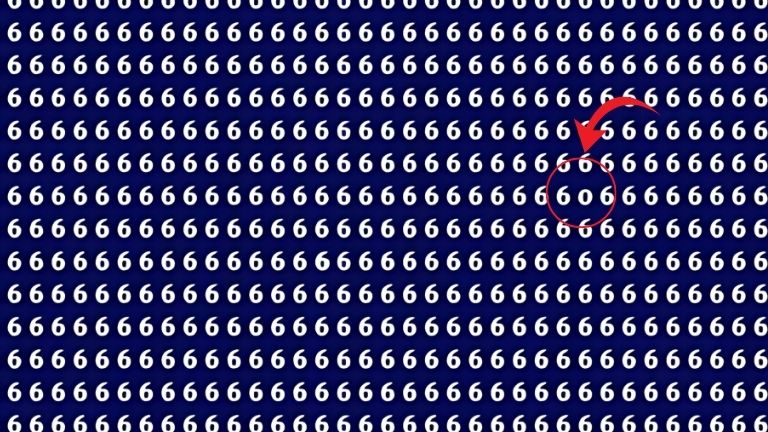Have you ever stared at something so simple yet felt completely stumped? That’s exactly what happens when you encounter the famous “zero among sixes” optical illusion that’s currently making waves across social media platforms.
This particular visual puzzle seems innocent enough at first glance. However, it quickly becomes a frustrating yet addictive challenge that tests your visual perception skills in ways you never imagined.
What Makes This Optical Illusion So Tricky?
The zero among sixes illusion presents viewers with a grid filled with the number 6. Somewhere within this sea of sixes, a sneaky zero is hiding in plain sight, waiting to be discovered.
Your brain processes visual information through complex neural pathways. When similar shapes cluster together, our minds often struggle to differentiate between subtle variations, creating the perfect conditions for optical confusion.

The Science Behind Visual Confusion
Our brains are wired to recognize patterns quickly and efficiently. This evolutionary advantage helped our ancestors survive by rapidly identifying threats or opportunities in their environment.
However, this same pattern recognition system can work against us in puzzles like these. The similarity between the number 6 and 0 creates what scientists call “visual interference.”
Why Some People Spot It Instantly While Others Struggle
Individual differences in visual processing play a huge role in puzzle-solving success. Some people possess what researchers term “superior visual scanning abilities.”
Others might have different strengths, perhaps excelling in mathematical reasoning or creative thinking instead. There’s no shame in finding these illusions challenging – it simply reflects the beautiful diversity of human cognition.
The Psychology Behind Our Fascination with Hidden Objects
Humans have an innate drive to solve puzzles and find hidden elements. This curiosity stems from our prehistoric need to locate food, shelter, and potential dangers in complex environments.
Modern optical illusions tap into these primal instincts. When we successfully spot the hidden zero, our brains release a small dose of dopamine, creating that satisfying “aha!” moment.
How Visual Puzzles Benefit Your Brain Health
Regular engagement with optical illusions and visual puzzles offers numerous cognitive benefits. These activities strengthen neural pathways responsible for attention, focus, and visual processing.
Think of these puzzles as a gym workout for your brain. Just as physical exercise strengthens muscles, visual challenges enhance your mental agility and perceptual skills.
The Social Media Phenomenon
Social platforms have transformed optical illusions from casual pastimes into viral sensations. People love sharing these puzzles because they create instant engagement and friendly competition among friends.
The zero among sixes challenge perfectly embodies this trend. Its simple appearance belies the genuine difficulty most people experience when attempting to solve it.
Strategies for Solving the Zero Among Sixes Puzzle
Systematic scanning represents the most effective approach for tackling this type of visual challenge. Instead of letting your eyes wander randomly, try dividing the image into smaller sections.
Start from the top-left corner and work methodically across each row. This organized approach reduces the likelihood of missing the hidden zero during your search.
The Peripheral Vision Technique
Sometimes, looking directly at the puzzle isn’t the best strategy. Try focusing on a central point while using your peripheral vision to scan the surrounding area.
This technique works because peripheral vision excels at detecting movement and differences in static images. The contrast between the zero and surrounding sixes might become more apparent this way.
Taking Breaks and Fresh Perspectives
If you’ve been staring at the puzzle for several minutes without success, step away briefly. Your eyes and brain need time to reset and approach the challenge with renewed focus.
Many puzzle enthusiasts report finding the hidden element immediately after returning from a short break. This phenomenon occurs because mental fatigue can impair visual processing capabilities.
The Role of Individual Differences in Puzzle Solving
Age factors significantly influence performance on visual puzzles like the zero among sixes challenge. Younger individuals often demonstrate faster processing speeds and more efficient visual scanning patterns.
However, older adults frequently bring superior problem-solving strategies and patience to these tasks. Experience and wisdom can sometimes compensate for slightly slower processing speeds.
Gender Differences in Visual Processing
Research suggests subtle differences between male and female visual processing abilities. Some studies indicate that women excel at rapid object identification, while men show advantages in spatial rotation tasks.
These differences are statistical tendencies rather than absolute rules. Individual variation within each gender far exceeds the average differences between genders.
Cultural and Educational Influences
Your cultural background and educational experiences shape how you approach visual puzzles. People from cultures emphasizing collective thinking might scan images differently than those from individualistic societies.
Educational training in fields like art, design, or mathematics can also provide advantages. These disciplines develop visual analysis skills that transfer well to optical illusion challenges.
The Neuroscience of Optical Illusions
Visual processing occurs through a complex network of brain regions working in coordination. The primary visual cortex receives raw information from your eyes, while higher-level areas interpret and make sense of this data.
Optical illusions exploit vulnerabilities in this processing system. They create situations where different brain regions provide conflicting information, leading to perceptual confusion.
Attention and Focus Mechanisms
Your brain can only process a limited amount of visual information at any given moment. This limitation forces your attention system to prioritize certain elements while filtering out others.
The zero among sixes puzzle challenges this attention system by presenting numerous similar elements. Your brain must work harder to distinguish between the target zero and the distracting sixes.
Pattern Recognition and Expectations
Humans excel at recognizing patterns, but this strength becomes a weakness in certain contexts. When your brain expects to see sixes everywhere, it might overlook the anomalous zero.
This expectation bias explains why some people struggle with these puzzles despite having excellent vision. Their brains are working too efficiently, automatically categorizing everything as a six.
Tips for Creating Your Own Visual Puzzles
Understanding how optical illusions work can help you create engaging puzzles for others. Similarity between the target and background elements is crucial for difficulty.
The zero among sixes works perfectly because these numbers share similar curved shapes. Too much difference makes puzzles too easy, while too much similarity makes them impossibly difficult.
Balancing Difficulty Levels
Effective visual puzzles require careful calibration of difficulty. You want them challenging enough to be engaging but not so difficult that people give up in frustration.
Consider your target audience when designing puzzles. Children might need larger differences between elements, while adults can handle more subtle variations.
Color and Contrast Considerations
Color choice dramatically impacts puzzle difficulty. High contrast between foreground and background elements makes hidden objects easier to spot.
Subtle color variations can increase difficulty while maintaining visual appeal. Experiment with different combinations to achieve your desired challenge level.
The Educational Value of Optical Illusions
Teachers and educators increasingly recognize the value of optical illusions in classroom settings. These puzzles engage students while teaching important concepts about perception and critical thinking.
Visual literacy becomes more important each year as our world becomes increasingly image-based. Understanding how our eyes and brains process visual information is a valuable life skill.
Developing Critical Thinking Skills
Optical illusions naturally encourage skeptical thinking and careful observation. Students learn not to trust their first impressions and to examine evidence more thoroughly.
These skills transfer well to other academic areas and real-world situations. The habit of questioning initial perceptions serves students well throughout their educational journey.
Applications in Special Education
Visual puzzles offer unique benefits for students with learning differences. They provide alternative ways to engage with educational content that don’t rely heavily on traditional reading and writing skills.
Many students who struggle with conventional academic tasks excel at visual challenges. This success can boost confidence and motivation across all subject areas.
The Future of Optical Illusions in Digital Media
Technology advances continue to create new possibilities for optical illusion design and distribution. Virtual and augmented reality platforms offer immersive puzzle experiences that weren’t possible before.
Interactive digital puzzles can adapt their difficulty based on user performance. This personalization ensures optimal challenge levels for individual users.
AI and Procedural Puzzle Generation
Artificial intelligence systems are learning to create optical illusions automatically. These programs can generate thousands of unique puzzles with varying difficulty levels.
However, human creativity and intuition remain essential for creating truly engaging and memorable visual challenges. The best puzzles combine algorithmic precision with human insight.
Mobile Apps and Accessibility
Smartphone apps have made optical illusions more accessible than ever before. People can enjoy these challenges anywhere, anytime, without needing printed materials.
Accessibility features in modern apps help people with visual impairments participate in puzzle-solving activities. These developments democratize access to visual entertainment and cognitive exercise.
Frequently Asked Questions
Q: How long should I spend trying to find the hidden zero? Most experts recommend spending 2-3 minutes actively searching before taking a break.
Q: Does having perfect vision guarantee I’ll spot the zero quickly? Not necessarily – visual acuity and pattern recognition are different skills that don’t always correlate.
Q: Are there any tricks to make these puzzles easier? Systematic scanning, good lighting, and maintaining proper viewing distance all help improve performance.
Q: Why do some people find these puzzles frustrating? Individual differences in visual processing and patience levels affect how people respond to challenging puzzles.
Q: Can practicing these illusions improve my general visual skills? Regular practice may enhance certain aspects of visual attention and scanning abilities.
Q: Is it normal to feel dizzy or strained when looking at these puzzles? Brief eye strain is common, but persistent discomfort might indicate the need for an eye examination.
Q: Do optical illusions work the same way for everyone? No – cultural background, age, experience, and individual brain differences all influence how people perceive illusions.
Q: Why do these puzzles become viral on social media? They create shared experiences and friendly competition while being easy to share and discuss online.
The zero among sixes optical illusion perfectly demonstrates how our sophisticated visual processing systems can be both remarkably efficient and surprisingly fallible. Whether you spot the hidden zero immediately or need several attempts, remember that these puzzles celebrate the fascinating complexity of human perception.
Next time you encounter one of these visual challenges, take a moment to appreciate the incredible neural machinery working behind the scenes. Your brain performs millions of calculations per second just to make sense of what your eyes are seeing – and sometimes, that’s exactly what makes finding a simple zero among sixes so delightfully difficult.
